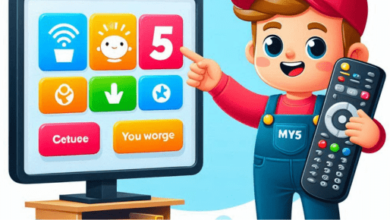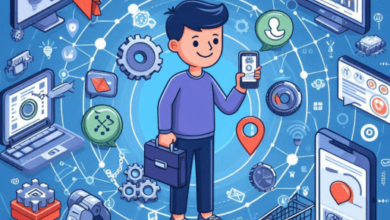The Evolution of Mobile Apps – Trends, Innovations, and Future Directions

Introduction
Mobile app development have profoundly transformed the way we interact with technology and each other. From the inception of simple utility apps to the complex, multifunctional platforms we use today, the evolution of mobile apps reflects broader technological advancements and shifts in user behavior. This article delves into the history of mobile apps, explores current trends and innovations, discusses the challenges developers face, and forecasts the future of mobile applications in a rapidly changing digital landscape.
The Historical Context of Mobile Apps
Early Days of Mobile Applications
The concept of mobile applications dates back to the early 1990s with the introduction of personal digital assistants (PDAs) like the Palm Pilot. These devices had limited functionalities but paved the way for more advanced mobile technologies. However, it wasn’t until the launch of the iPhone in 2007 that mobile applications truly began to gain traction. The App Store, introduced in 2008, allowed third-party developers to create and distribute applications, leading to an explosion of mobile app usage.
The Rise of Native and Web Apps
In the early days, mobile apps were predominantly native applications, developed specifically for a particular operating system, such as iOS or Android. These apps offered optimal performance and user experience but required separate development for each platform. With the increasing prevalence of mobile devices, the need for cross-platform solutions emerged.
Web applications, accessible via browsers, provided an alternative to native apps. Although they offered broader accessibility, they often lacked the functionality and responsiveness of native apps. As technologies evolved, hybrid applications emerged, combining elements of both native and web apps, allowing developers to write code once and deploy it across multiple platforms.
Current Trends in Mobile App Development
1. The Rise of No-Code/Low-Code Development
As businesses strive to keep pace with rapid digital transformation, the demand for mobile applications has skyrocketed. No-code and low-code development platforms have emerged as a solution, enabling individuals without extensive programming knowledge to create functional apps. These platforms streamline the development process, allowing businesses to prototype and launch apps more quickly, thus reducing time-to-market and associated costs.
2. Focus on User Experience (UX) and User Interface (UI) Design
In an era where user attention is fleeting, the emphasis on exceptional user experience and intuitive user interface design has never been greater. App developers are increasingly adopting design thinking principles, which prioritize understanding users’ needs and preferences. This approach not only enhances usability but also fosters customer loyalty. Trends like minimalistic design, dark mode, and personalized content are shaping how apps are designed, ensuring they meet user expectations.
3. Integration of Artificial Intelligence (AI) and Machine Learning (ML)
AI and ML are playing a transformative role in mobile app development. These technologies enable applications to provide personalized experiences by analyzing user behavior and preferences. For example, fitness apps can track user activity and suggest tailored workout plans, while e-commerce platforms can recommend products based on past purchases. As AI continues to evolve, its integration into mobile apps will become increasingly sophisticated, leading to smarter and more intuitive applications.
4. Increased Emphasis on Security
As mobile apps handle sensitive user data, security has become a paramount concern. The rise of data breaches and privacy regulations has prompted developers to prioritize robust security measures. Implementing features like biometric authentication, end-to-end encryption, and regular security audits is now standard practice. Moreover, businesses are increasingly focused on ensuring compliance with data protection regulations, such as GDPR and CCPA, to build trust with users.
5. Expansion of Augmented Reality (AR) and Virtual Reality (VR)
AR and VR technologies are redefining user experiences in mobile applications. Retail and gaming sectors, in particular, are harnessing these technologies to create immersive experiences. AR applications allow users to visualize products in their environment before making a purchase, while VR applications transport users into entirely different worlds. As hardware capabilities improve and 5G networks expand, the potential for AR and VR in mobile apps will continue to grow.
Innovations in Mobile App Functionality
1. Chatbots and Conversational Interfaces
Chatbots are revolutionizing customer service within mobile apps. By integrating AI-driven chatbots, businesses can provide instant support and assistance, reducing wait times and enhancing user satisfaction. These conversational interfaces are designed to handle inquiries, provide recommendations, and facilitate transactions, making the user experience more efficient and engaging.
2. Mobile Payment Solutions
The adoption of mobile payment solutions is reshaping the way consumers conduct transactions. Mobile wallets, such as Apple Pay and Google Pay, allow users to make secure payments directly from their devices. This convenience has led to increased mobile commerce and has prompted businesses to integrate payment processing into their apps. As more consumers embrace contactless payments, the demand for secure and user-friendly mobile payment options will continue to rise.
3. Internet of Things (IoT) Integration
The integration of IoT technology into mobile apps is enhancing user experiences and creating new opportunities for businesses. Mobile apps can now control and monitor smart devices, such as home appliances, wearables, and security systems. This functionality not only offers convenience but also allows users to gain insights into their usage patterns, leading to more informed decision-making.
4. Subscription Models
The subscription-based model is gaining traction in the mobile app industry, providing businesses with a steady revenue stream. Apps offering premium content, services, or features can implement subscription plans, allowing users to access exclusive benefits. This model encourages user retention and fosters a loyal customer base, as users are more likely to stay engaged with apps they are financially invested in.
Challenges in Mobile App Development
1. Competition and Market Saturation
With millions of apps available in app stores, standing out in a crowded market is a significant challenge. Developers must invest in marketing and user acquisition strategies to capture users’ attention. Additionally, continuous innovation is essential to keep users engaged and prevent them from abandoning the app for competitors.
2. Device Fragmentation
The variety of devices and operating systems complicates mobile app development. Developers must ensure their apps function seamlessly across different screen sizes, resolutions, and OS versions. This fragmentation requires thorough testing and optimization, which can extend the development timeline and increase costs.
3. Maintaining Performance and Speed
As mobile apps become more feature-rich, ensuring optimal performance and speed is critical. Users expect quick load times and smooth navigation, and any delays can lead to frustration and abandonment. Developers must carefully balance functionality and performance, optimizing the app to ensure it runs efficiently on various devices.
4. Keeping Up with Rapid Technological Changes
The mobile app landscape is constantly evolving, with new technologies and trends emerging regularly. Developers must stay informed about these changes to remain competitive. This necessitates ongoing training and development, which can strain resources, particularly for smaller businesses.
The Future of Mobile Apps
1. Greater Personalization
As AI and data analytics technologies continue to advance, personalization in mobile apps will become even more refined. Apps will increasingly leverage user data to provide tailored experiences, from content recommendations to customized interfaces. This level of personalization will enhance user engagement and satisfaction, fostering brand loyalty.
2. More Focus on Accessibility
Ensuring accessibility for all users is becoming a priority in mobile app development. Developers are recognizing the importance of creating apps that accommodate individuals with disabilities. Future apps will incorporate features such as voice commands, screen readers, and adjustable text sizes to provide a more inclusive experience.
3. Environmental Sustainability
As awareness of environmental issues grows, businesses are increasingly prioritizing sustainability in their operations. Mobile apps will play a role in promoting sustainable practices, whether through carbon footprint tracking, sustainable shopping options, or features that encourage eco-friendly behaviors. Developers will be challenged to create apps that not only meet user needs but also contribute positively to the environment.
4. Enhanced Collaboration Tools
The rise of remote work has highlighted the need for effective collaboration tools. Future mobile apps will continue to evolve in this space, offering features that facilitate seamless communication and project management among distributed teams. Integration with existing workplace tools will be crucial for creating cohesive workflows.
5. Integration with Blockchain Technology
Blockchain technology is making inroads into mobile app development, particularly in sectors like finance and healthcare. Its ability to provide secure, transparent transactions can enhance trust and security within mobile apps. Future applications may utilize blockchain for secure identity verification, supply chain management, and more, offering users increased confidence in data integrity.
Conclusion
The evolution of mobile apps reflects a dynamic interplay between technological advancements and changing consumer expectations. As we move forward, businesses that prioritize innovation, user experience, and security will thrive in this competitive landscape. By embracing emerging trends and addressing challenges, developers can create mobile applications that not only meet user needs but also enhance overall engagement and satisfaction.
As the mobile app ecosystem continues to evolve, staying informed and adaptable will be key to unlocking future opportunities. The potential for innovation is vast, and those who invest in understanding and leveraging these trends will be well-positioned to succeed in an increasingly mobile-centric world. Ultimately, the future of mobile apps is bright, driven by creativity, technology, and a commitment to enhancing the user experience.




